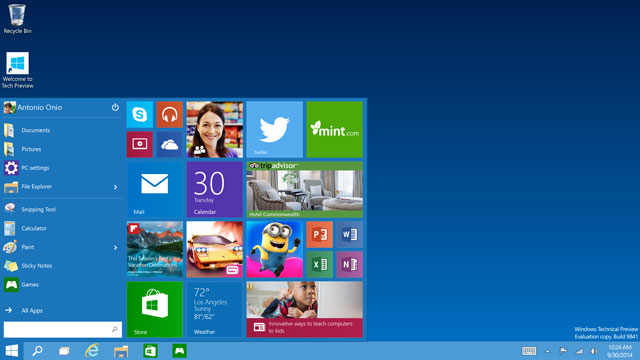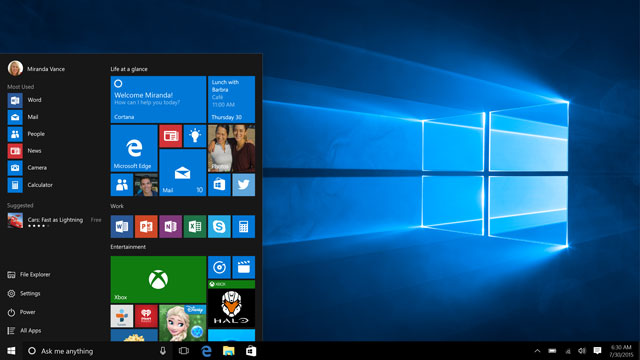
This week marks one year since the launch of what is arguably Microsoft’s most ambitious — and possibly most controversial — operating system: Windows 10.
Windows 10 represents a fundamentally different approach compared to the earlier versions of Windows that many of us have used, such as the highly popular Windows 7.
With Windows 7, Microsoft understood what desktop users wanted and delivered a product to satisfy their demands. Windows 7 loaded quickly, it made media sharing easy, it was more secure than the earlier Windows XP, gamers loved it, it used less power and Windows Media Centre was a useful interface for watching media.
But rather than being exclusively for desktop PCs, Windows 10 aimed to service three different platforms: PC, tablet and smartphone.
In many ways, Windows 10 is an evolution of its previous iteration, Windows 8 (there was no Windows 9). Microsoft has taken the same cross-platform philosophy and refined it to remove some of the issues that proved unpopular with users.
But Microsoft’s first attempt to appeal to the desktop and mobile market in a single OS failed badly in two ways.
Firstly, Windows 8 never gained a significant market share in the mobile space. Secondly, it compromised the experience for desktop users by forcing them to use an interface system designed with touchscreen tablets in mind.
The Start menu — a fixture since Windows 95 — was removed in favour of a start screen, which proved to be a disastrous move.
Even experienced Windows users could not find the common functionality they regularly used. Microsoft’s app store was launched to compete with Apple and Google, but it failed to attract quality developers. This had a flow-on effect on the mobile/tablet market as many apps that people used were not available on Windows 8.
Windows 10 was a result of the learning experience from Windows 8. The user interface is significantly improved as part of the “Continuum” concept, which senses the device you are using and adjusts itself accordingly.
The Start button was back with the addition of Live Tiles, which display information at a glance without opening an app or program.
Microsoft also introduced Cortana, which is couched as a virtual personal assistant, and a new Web browser, Edge.

Who’s watching?
However, one of the features that drew the most attention, and the most controversy, was the way Windows 10 tracked user data and provided targeted advertising in return.
This was one way that Microsoft could afford to offer Windows 10 as a free upgrade from Windows 7 and 8 until July 2016.
But many users did not welcome the tracking of their personal information. As some have said, Microsoft used to monetise its operating systems by offering it as a product and charging money for it, but with Windows 10, Microsoft is monetising its customers by gathering their data and turning that into a product to sell to advertisers.
While many companies, such as Google and Amazon, regularly gather user data and target advertising at them through their online portals, many people objected to Microsoft using their entire operating system to track them.
The feeling of your desktop tracking your actions and sending out this information is disturbing to many people. People strongly feel that their desktop belongs to them because they paid for it (even though Windows 10 was offered free to most users), unlike websites for which they did not.
Microsoft has also had legal trouble in France over Windows 10 practices regarding privacy, security and user data collection. This may be the first case, but likely won’t be the last one.
Out of 10?
Despite the privacy concerns, Windows 10’s features have expanded over its first year. Cortana now shares maps, tracks lost phones and sends photos from phone to PC with voice commands.
Edge now uses less power, allows note taking on Web pages and provides a reading view for distraction-free reading of Web content.
In August 2015, Microsoft launched an Internet of things (IoT) framework to offer support for developing IoT apps on Windows 10 using Raspberry Pi, which is a miniature low-cost computer.
In terms of security, Microsoft added Device Guard, which can ensure only permitted programs will run.
It also disabled the controversial Wi-Fi Sense, which was included at launch and allowed shared users’ Wi-Fi passwords with Outlook and Skype contacts.
Microsoft’s mobile strategy progressed further with Continuum, which now allows any monitor to be used as a computer by plugging in a Windows 10-enabled smartphone.
Another change to Microsoft’s strategy is that there won’t be new standalone versions of Windows, but rather incremental functional updates to Windows 10.
Overall, Windows 10 was a successful strategic move by Microsoft to leverage its desktop user base and guide them to tablets, mobiles and then to the cloud. It learnt from the mistakes of Windows 8 and developed an OS platform that has shown potential to be successful.![]()
- Vidyasagar Potdar is senior research fellow, School of Information Systems, Curtin University
- This article was originally published on The Conversation

